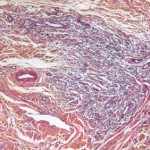We just lost a beloved family member, our ten-year-old Tibetan terrier Yoda, to a malignancy that I'd never heard of, an enormous mast cell tumor. It made its initial appearance only eight days previously while I was in Memphis at a 90th birthday celebration. My wife called me and said Yoda had swelling in his neck and a cough.
She took him in to the multi-veterinarian clinic where he's been going for ten-plus years and they were puzzled. They were unsure of which of four possible diagnoses was causing his problems. He got an antihistamine and a broad spectrum antibiotic and improved considerably. When he lost his appetite on a Sunday afternoon, we spoke to the on-call veterinarian who felt he should be seen early on the next morning.
By then his neck was swelling again and we were promptly referred to the CSU Veterinary School's hospital. They got him into their urgent care system, aspirated some cells from his neck and told us he had a mast cell tumor. The literature they supplied said these are extremely rare in humans, but common in dogs.
A short while later his neck was swollen to the point where he needed to be intubated in order to breathe. The only creatures I had ever seen with a similar appearance were great frigate birds in the Galapagos. In their case, the pouch is inflated by the male birds to attract a possible mate; in Yoda's case the malignant mast cells had "degranulated" releasing histamine and other mediators of immunity.
Our surrogate son, now in his second medical career, had never seen a mast cell tumor and both of us had to return to memories of our freshman years in medical school (mine considerably before his) and to Google the term to remember exactly what a mast cell is and what physiologic role it plays.
I went back to the Web and read about mast cells and their companions in allergic inflammation; it was a highly technical article written for allergists and immunologists, so I struggled a bit. Let's start with the immunoglobulins, our antibodies. There are five classes of these chemicals which are manufactured by the body in response to foreign substances (antigens) such as pollen, bacteria, or cancer cells. Three of them, termed IgA, IgG and IgM were familiar to me.
IgA antibodies protect our body surfaces (e.g., nose, digestive tract, eyes & ears) that are often bombarded with outside antigens. IgG antibodies are the smallest, the only immunoglobulin that can pass through the placental barrier to a fetus, and make up nearly 80% of all of these immunity chemicals. They help protect us against bacterial and viral infections. IgM antibodies are much larger, play an important role in our initial line of defense versus infections and are produced, to a large extent, in the spleen.
IgD was the mystery antibody for many years; recently it has been felt to be a surveillance system, binding to one kind of blood cells and setting off an intricate series of protective processes.
So that left IgE whose connections with allergic reactions was clear. Along with blood cells known as basophils and eosinophils and "tissue-based" mast cells, IgE is a crucial factor in inflammation associated with allergy.
I mentioned that mast cells are tissue-based; they're not something you'd see in a normal CBC (complete blood count), but "hang out" in association with blood vessels and on epithelial surfaces (your skin is classed as such, but epithelial tissues also line the cavities and surfaces of structures throughout the body, and also form many glands). Mast cells are "cousins" to basophils, similar in appearance and function, and containing histamine and heparin, but are thought to be generated in the bone marrow from different precursor (ancestor) cells.
They have a highly significant part in the inflammatory process and team up with IgE which coats their outside surface. They have key roles in asthma, a variety of itches, and allergic rhinitis (one form of this disorder would be "There's pollen in the air so my nose gets clogged up and I sneeze."). They're also crucial in immediate hypersensitivity, severe kinds of allergic reactions that can be life-threatening. One example of this would be a person who has a severe, potentially fatal reaction to a bee sting. The medical term for this is anaphylaxis.
Mast cells can cause diseases in people; one type leads to pigmented skin areas that when stroked develop hives. Rarely do human mast cells lead to malignancies. I talked to a physician friend who had seen one case in her career and found an online series that had a total of three cases.
In dogs, on the other hand, mast cell tumors are relatively common, but most are lumps that can be removed surgically. A smaller number of canines develop larger tumors and a few have even more malignant disease.
Unfortunately, our dog Yoda had one of the bad kind. His was the largest, most rapidly-growing mast cell cancer the Vet School's senior oncologist had ever seen.
We'll miss him. He was an important and much-loved part of our family.



